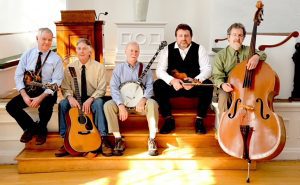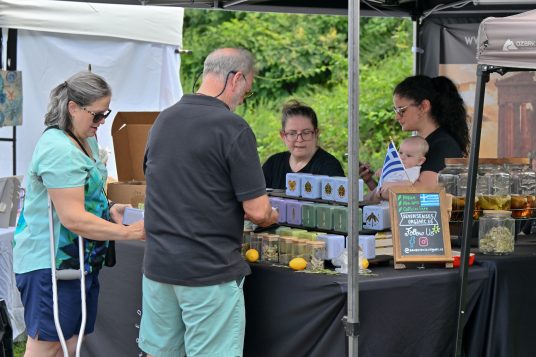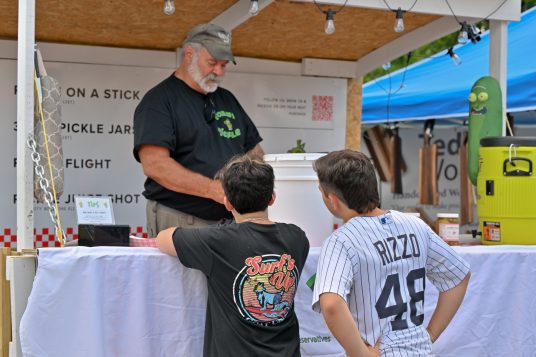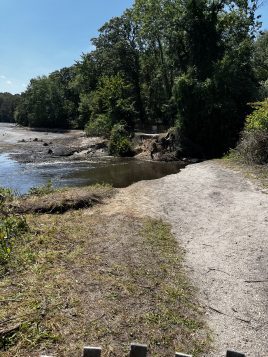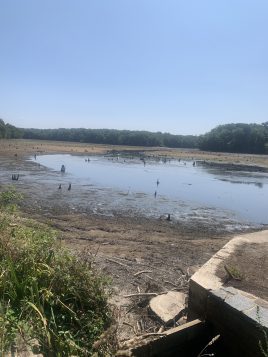By Kurt Johnsen
To say the least, it was a gut punch when I heard and saw the footage that Harbor Road and the dam at the Mill Pond in Stony Brook was breached by the “thousand-year” rain. The water cascaded into the creek with its fish, turtles and plethora of biodiversity. Most of it settled into the harbor. In a flash, a diamond of my childhood was swept away with it.
In 1965, when I was 5 years old, I got my first Mill Pond Fishing Club badge and enjoyed my first opening day of trout season. It was a cold April morning when my father and I chose our place on the shore. I followed his instructions and put the worm on the hook. I cast out my bobber and bait. I know I cast because we had practiced in our backyard. After a while my bobber started to jiggle. Then it dipped below the surface of the water — I reeled in my first trout. The sky opened, and God spoke: “You are a fisherman.”
Next, we went to the Stony Brook Yacht Club. The adults served ham and eggs on hard rolls. Then it was time for the momentous occasion: the fishing contest. The first announcement was the winner of the junior category. I won! At all future family gatherings from that day forward, including one last week, I repeat the words my 5-year-old self said that day: “They put me up on a table and they all said “’ratulations.” I won a fishing pole and a tackle box, but the memory was worth far more than these prizes.
For the next couple of years, my father and big brother took me fishing at the pond frequently. The prelude to fishing started the night before. I was taught how to catch “night crawlers.” These meaty worms are perfectly named. They burrow out of the soil at night to garner more oxygen. Catching them is an art. The light from the flashlight does not bother them, but with any perceived motion they disappear back into the soil. I had to be slow, quiet and swift to grab them. The grass below our large cherry tree was the hotspot. We picked nice healthy fistfuls of large worms and put them into an old tobacco can, where they spent the night in the fridge.
Although it seems incomprehensible in 2024, in those days the pond was pristine. Brook trout spawned in the small creek near the upper pond. My big brother showed me that if I slowly and carefully walked on the small bridge next to where the cup where the spring water comes out of a tap, I could see them. Brook trout require cold, clean, brilliant water. Those were the days.
By the time I was 9 or 10, I could go down to the pond by myself. I remember one opening day when I walked to the dairy barn, down the woody path, over the railroad tracks, down Blydenburgh Lane, across Main Street to the sidewalk in front of the lumberyard and over to the pond. I parked myself at “my” tree, a red maple (it survived!), and my cast had to go right under a certain branch that draped low to the water. I swear the trout loved that place. I counted down, “5-4-3-2-1: 6:00,” and it was time to cast. Fish, breakfast, contest and, if need be, back to the pond to get my limit of three.
Even now, when I arise on a serene morning laced with dew, and the sparrows are singing hushed but bright melodies, I am transported back to those days. It’s magical.
At some point, I was given a bright red badge that simply said “Warden.” My job was to report anyone that was fishing at the pond that wasn’t a member. The gig was to go to the village office to the right of the post office and report the infringement to a nice man named Mr. Murphy. He would then go down to the crime scene, perform a thorough investigation and, if there was sufficient evidence, lay down the law and tell them to leave. It happened once. I was a Trout Narc.
With the summer heat, the trout would stop biting. We fished for small, inbred, stunted bass as well as sunfish. And we snuck onto the trail to the woody back of the pond adjacent to the upper pond. There were large oaks that had fallen into the pond but still lay across it. We would climb out to the end of them and try to fish. We mostly lost our hooks.
Speaking of the upper pond, it was loaded with huge trout. We were not permitted to fish in it but, of course, we did. When we were about 10 years old, my friend Eddie and I fished the pond. I caught a very big trout and hooked it on a stringer. An old lady who lived across the street — a legend in her own time — came rushing up to us maniacally screaming that we couldn’t fish there.
She took my trout and threw it out into the pond and then harrumphed away. I was not happy. I was taking off my shoes and shirt and ready to swim out to get it. Then, I swear, a guy backed up an old woody station wagon to the pond. He opened the back hatch, pulled out a piece of plywood to make a ramp and slid a giant snapping turtle into the pond — remember that we were 10. At that point, I was damn well not going to swim out to get my trout!
The dog days of summer meant carp fishing. In the evenings, my friends and I would fish near the end of the pond left of the big buckeye tree and right of the point across from the island. I could see the shadows of the giant carp come lumbering in, and if I was lucky I got one. I was only lucky a couple of times. Deemed a danger to the trout population, we threw these carp down the ramp that led out of the dam and into the creek. We were proud to be good citizens and help our invaluable trout population. Plus, it was fun. Everything was fun at the Mill Pond.
As you might guess by now, although I lived in Stony Brook surrounded by salt water, I was a freshwater fisherman. I still am. If you were around in the late 1960s and early ’70s and were driving on Stony Brook Road or Route 25A, you likely saw a boy riding his bike holding a fishing pole and a stringer of fish in his hand. That boy was me.
The Mill Pond Fishing Club sponsored me to go to the New York State Department of Environment Conservation Camp DeBruce in Sullivan County in the Catskills. We campers got fly-fishing lessons, learned to identify trees, learned how to conduct fish surveys in a stream and more. At that point I knew I wanted to work in fisheries or forestry.
I am now a forest scientist. I was 15 in my last year in the club. On my final opening day, I won first place again. Bookends. I think it was that year they stocked a “breeder.” It was a brown trout with a hooked jaw that weighed 6 pounds. It was immediately proclaimed “the big trout.” I caught it. I still have all my badges from my years in the fishing club in my treasure chest.
When I turned 17, I became an Eagle Scout. For my Eagle project I led a group of boys in making wood duck houses. Wood ducks are small, fast-flying, colorful ducks that nest in tree cavities. They became threatened in the early 20th century. I hoped I could attract them to the pond. The group constructed three houses in my father’s wood shop. And then a few of us, led by an adult, paddled to the island with a ladder and we hung three boxes on trees that were meant to act as cavities. I never observed any wood ducks at the pond, but you never know. I was so proud of those houses.
My wife and I are fanatical Beatles fans. When I heard and saw how the Mill Pond was destroyed, I felt the same emotion that I felt when I heard John Lennon was murdered, a horrific memory etched in my psyche. People have told me those two events are not comparable, but for me there was Sgt. Pepper and the Mill Pond. What can I say?
I do think the pond will live and thrive again. It isn’t just a matter of making a new dam and letting the pond fill again. It’s not a fishbowl. It was and will be an intricate ecosystem, and it will take time to recover. Hard decisions will have to be made. What species of fish will be stocked? Just trout? Bass? Even carp? We’ll see.
The new dam will have to be skillfully engineered and built. The old Harbor Road was just a thin slice of hardtop sitting on top of sand. The new road needs to be reinforced to withstand the raging storms that will haunt us as climate change continues to uproot our lives.
However, the barren Mill Pond presents an opportunity for important archaeological explorations. With its cold, pure, fresh water, the small creek flowing out of the deep springs must have been an important feature of native tribes’ lives. An abundance of precious relics certainly reposes under the centuries of sediment deposited since the first Grist Mill was built in 1699. Clearly, the ancestors of the indigenous Setalcott Indian Nation should be the first to provide input on how to proceed.
This may seem an odd way to end my essay, but there is an elephant in the room: the white ducks! Had you visited the Mill Pond even the week before last, you would have witnessed a horde of people throwing handful after handful of white bread into rafts of white ducks. Make no mistake, these creatures are not native to the pond. They can’t fly, are prodigious breeders and are permanent inhabitants. Those cute little chicks given to kids for Easter grow fast, and where do they end up? The Mill Pond.
The bread that is fed to them is foul (pardon the pun) and provides no nutrition. If you could even see the water through the flock, you would not see past the dissolved bread and duck waste that denudes the water, the essence of life. This practice needs to be discouraged. Education is the key. There is a predominant sign at the entrance to the park informing the public about the harm that feeding bread to ducks may cause. Let’s hope people pay more attention to that sign to remind them that they are privileged to enjoy a rare ecosystem in Stony Brook, New York.
I can’t wait to visit the restored Mill Pond, the gem of my childhood.
Author Kurt Johnsen is a resident of Asheville, North Carolina.



